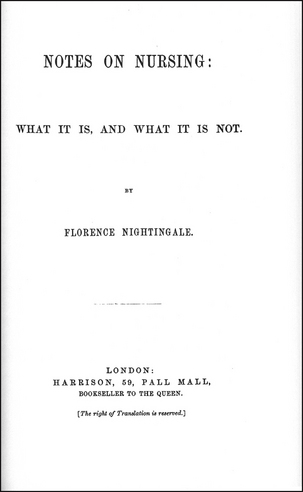1 The Background to Florence Nightingale’s Notes on Nursing
The original Notes on Nursing by Florence Nightingale was published in 1859, when she was nearly 40 and already a legend for her work to advance nursing and healthcare. In a letter to a friend she wrote about the book that: ‘There is not one word in it written for the sake of writing but only forced out of me by much experience in human suffering.’
The Crimean War experience confirmed her conviction about the link between good hygiene and illness. It did not take long for her to see that wounded soldiers who might recover were being killed by having to live in filthy conditions. She earned an almost saintly reputation for her work tending those wounded and dying soldiers. Queen Victoria wrote her letters of praise, and governments sought her advice. But it was the lessons she had learned about how to create environments that favored recovery and well-being that she valued and continued to apply later in proposing reforms to how hospitals were built and how they should be managed.
The ‘lady of the lamp’
Now the ‘lady of the lamp’ was offering in her Notes to caregivers some down to earth advice that ran counter to common beliefs and assumptions about illness, personal hygiene and healthy households. This small book caused a sensation; it became an instant best seller. An astounding 15,000 copies were sold in the first month, occasioning many reprints and subsequent editions. It was quickly translated into many languages.
The miasma model centered on beliefs which considered that illness was caused by poor hygiene and its consequences: bad air and odors, rotting food, sewage, and lack of light and fresh air. Under this model, treatment involved personal and environmental cleanliness, access to fresh air, scrubbing, boiling and bleaching. It was from this model of healthcare that Florence Nightingale began her work, applying her talent for organization and an incisive mind to set out a series of practices that were precursors of the future, when research would at last reveal that a series of tiny microorganisms were in fact the agents of disease. The methods of care that she devised before this was clearly understood and accepted proved perfectly compatible with this discovery, and remained an effective approach to combating ‘germs,’ the enemies of good health and well-being. It is instructive in reading her advice to caregivers to obtain a better grasp of ‘where she was coming from,’ how she learned the lessons she would later dispense, and to understand on the basis of what knowledge she was able to determine how nursing and caregiving could be immeasurably improved.




